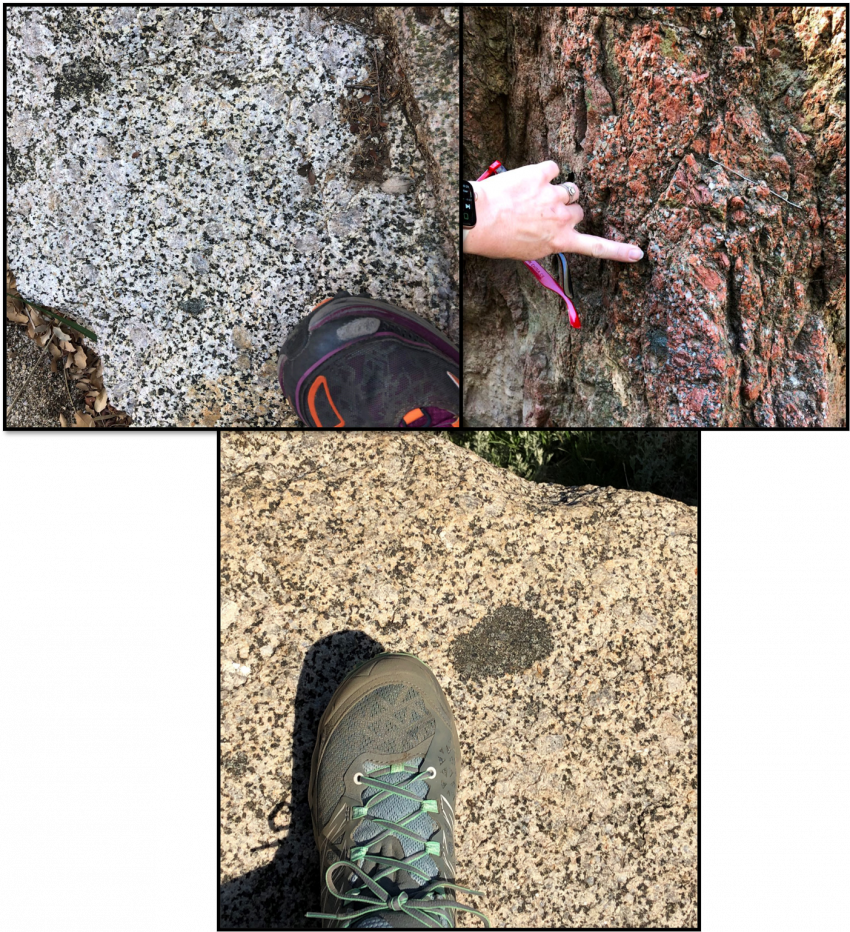Have you ever wandered into a countertop store and checked out the ‘granite’ selection? Well, if you are a geologist you likely have (because shiny, polished rocks!) and I can guarantee that many of the options they have shown as granite aren’t technically granite (some may not even be in the granite family). In this post we are going to dive into the wonders of all things granite!
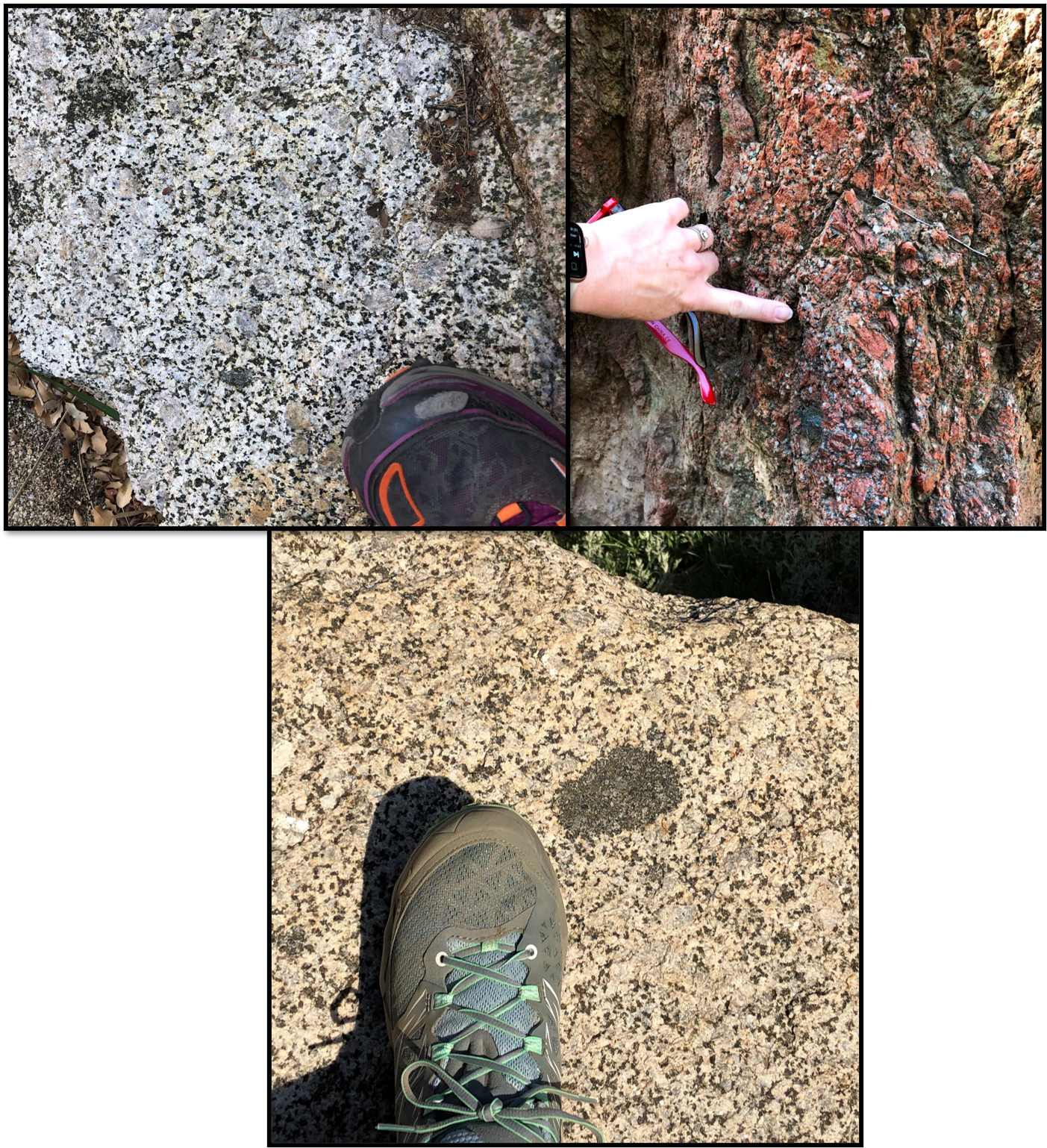
What is Granite?
If we want the technical geologic definition (which here at Backyard Geology we try to be technical), then a granite is defined as a phaneritic, plutonic, igneous rock that contains 20-60% quartz and 10-60% some combination of feldspars (plagioclase and alkali)1. Before I go any further, let me define some of the geology jargon I threw at you in that previous sentence. In a previous post, Kristen defined intrusive rocks (cooled below the surface) for us. Plutonic and intrusive can be used interchangeably, they both mean a large body of magma that cools and crystallizes below the Earth’s surface. The term phaneritic is one of many descriptor terms geologists use to describe the size of the crystals in a rock. Phaneritic means that you can easily see the individual crystals of a rock with the naked eye (unaided by a microscope). It also tells us that the rock cooled slowly enough for the crystals to grow large.
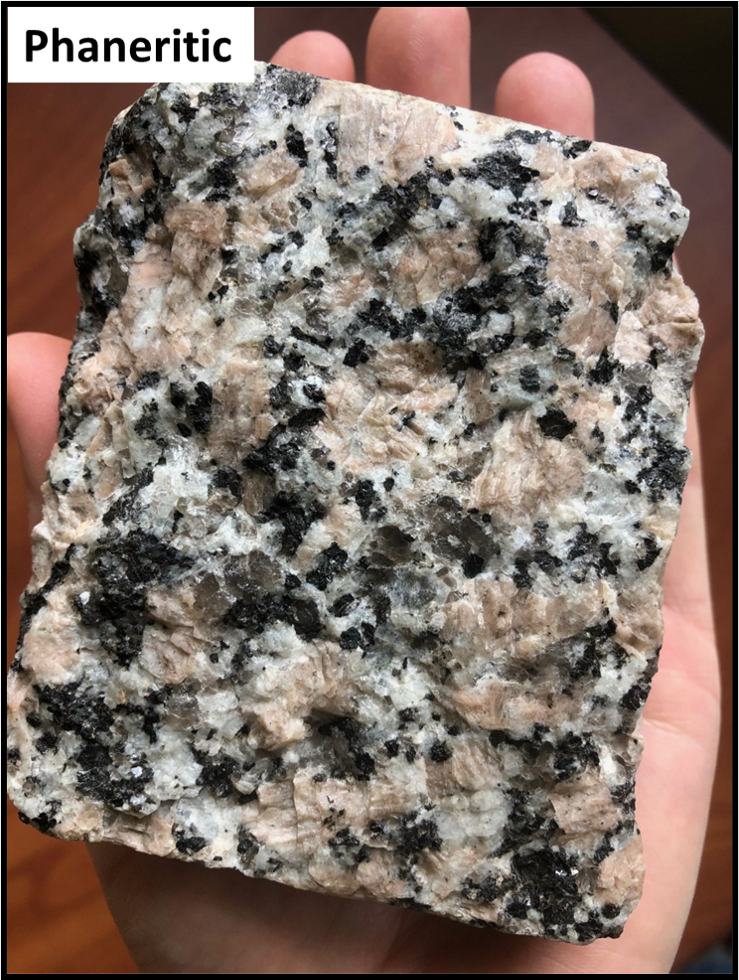
The last piece we need to break down are the different minerals I mentioned, which are the dominant minerals that make up a granite. Quartz is a very common mineral and is found pretty much everywhere (chances are good for you to find quartz near you!). The feldspars are minerals very often found in igneous rocks. They can be potassium-rich, sodium-rich, calcium-rich or somewhere in between the three. In granites we typically find potassium and sodium- rich feldspars because of the temperatures they are happiest to form at (approximately 600-700 degrees Celsius or 1112-1292 Fahrenheit2). The figure below illustrates these primary minerals found in granite.
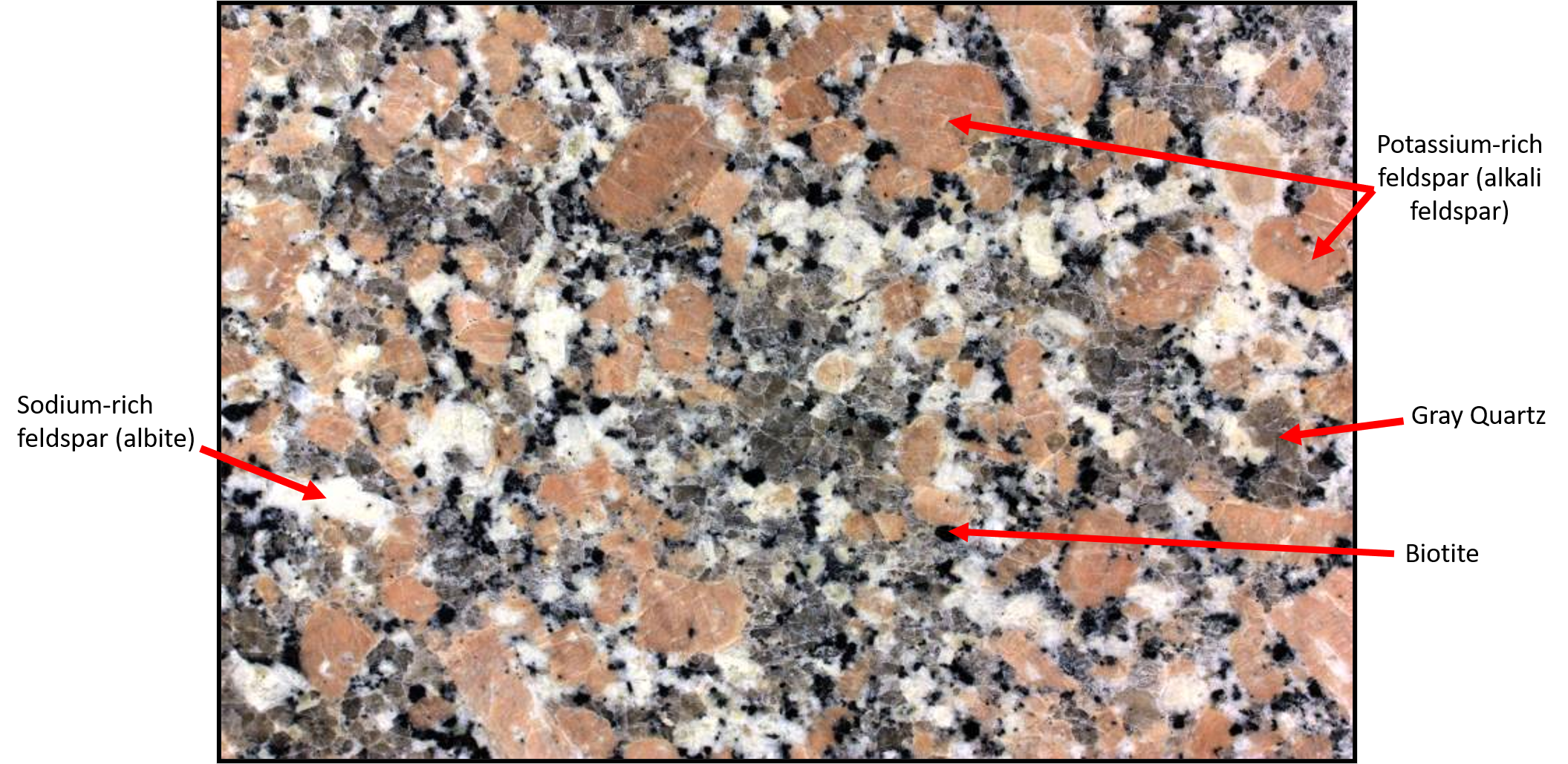
How Do We Classify Granite?
As mentioned in the previous section, granite has specific amounts of feldspar and quartz in order to be classified as granite. It is no secret geologists love charts & diagrams for classifying rocks and it is no different for plutonic igneous rocks! Geologists will look at a slab of rock and estimate to the best of our abilities (or have a computer program do it for us) the percentages of those minerals within that rock. From there we use a specific diagram called a QAP diagram. The figure below illustrates this diagram. Each corner of the triangle represents a different mineral. The Q represents quartz, the A represents alkali feldspar (potassium and/or sodium varieties), and the P represents plagioclase feldspar (calcium-rich variety). The first thing you will likely notice though, is the amount of individual crazy sounding names on this diagram and a specific space for our granite based on those above percentages. These are all different varieties of granite-like rocks, granitoids (a fabulous lumper term we use for rocks that contain varying amounts of quartz and feldspar- i.e., some of the crazy names on this diagram).
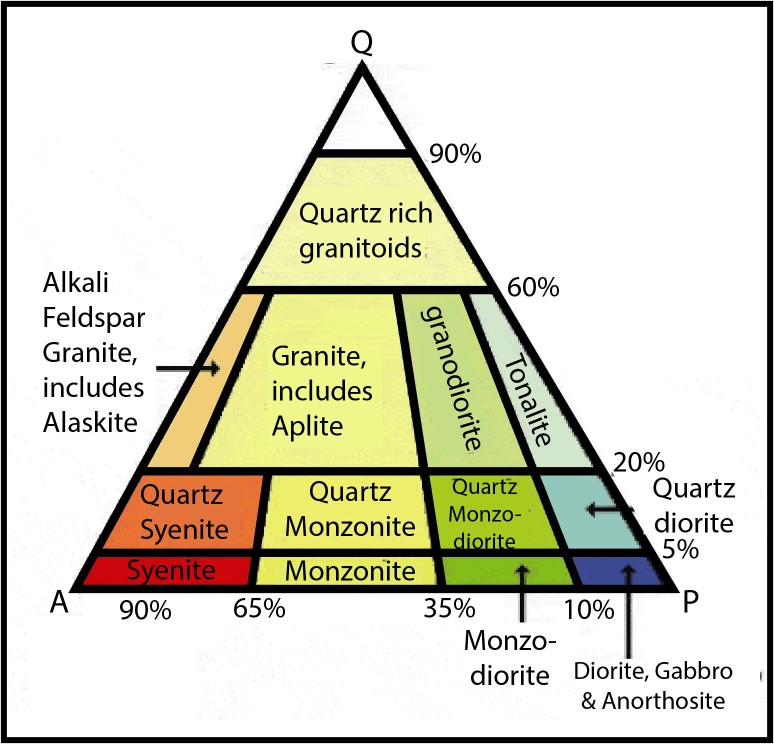
Geologists are not the only ones who classify granite. The commercial industry does as well, e.g., the countertop world of the commercial industry. They consider any rock that has visible interlocking grains and is harder than marble to be a granite 3. So rocks that are not even igneous (metamorphic typically) get put into the category of granites. While there are plenty of actual granite countertops out there, there are many that are not granites by a geological definition.
Where is Granite Found?
Since we have already established that granite forms deep below the Earth’s surface, how can we see it so well exposed in many places around the world? Because granite forms within the continental crust (the part of the Earth’s surface we live on), these rocks are often brought to the surface over the course of millions of years through erosional processes (the material on top gets scraped away exposing the granite deep below), through mountain-building processes, or a combination. Mountains form when two continental plates collide and are compressed together. As this happens rocks that are deep below the surface can be brought to the surface. A modern day example that is actively ongoing is the formation of the Himalayan mountains. The Rocky mountains, the Appalachian Mountains, The Pyrenees, and so many more ancient mountain belts have formed through the combination of these processes and have brought geologic treasures from deep below up to the surface. Massachusetts, New Hampshire, Georgia (north and south Appalachians) and Idaho (Rocky Mountains) are a few examples of granite-producing states here in the US3.
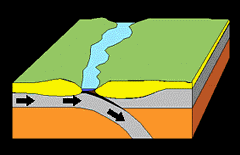
If you have visited Albuquerque, you have witnessed the beauty of the Sandia Mountains that sit to the East of the city. The Sandia mountains are made of primarily what is known as the Sandia granite (with some limestone at the top, but that is for another day). The granite exposed here is approximately 1.4 billion years old. It was exposed at the surface not because of colliding plates, but a plate being pulled apart (rifted). Approximately 26 million years ago4 this region of the continental plate began to be pulled apart. When that occurred one side of the rift dropped down as the other rose up. This action brought the granite that was buried deep below the surface upwards, lifting it above the surface as the rest of the Sandias formed. The GIF below illustrates this action.
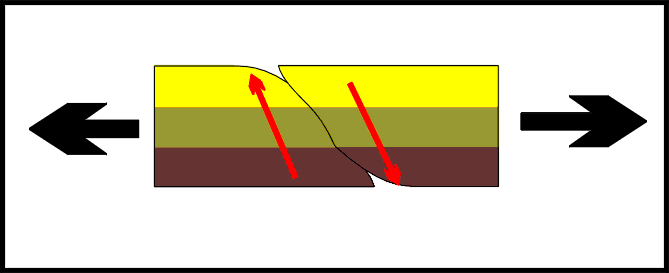
Phew! That was a lot of information on the fabulous rock, granite! We hope you enjoyed the ride!
References:
1United States Geological Survey, Earth Materials; granite: Accessed 6/23/2021. https://mrdata.usgs.gov/catalog/science.php?thcode=4&term=4.4.2
2Luth, W. C., Jahns, R. H. & Tuttle, O. F., 1964, The granite system at pressures of 4 to 10 kilobars: Journal of Geophys. Res. 69, 759–773.
3King, H.M., Granite; Geology.com. Accessed 6/24/2021. https://geology.com/rocks/granite.shtml
4Geologic Tour of the Rio Grande Rift, 2021, New Mexico Bureau of Geology and Mineral Resources, New Mexico Tech. Accessed 6/24/2021. https://geoinfo.nmt.edu/tour/provinces/rio_grande_rift/home.html

